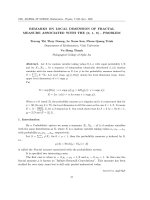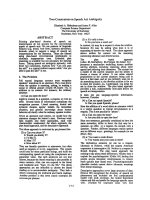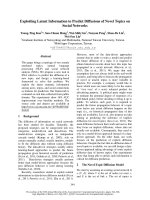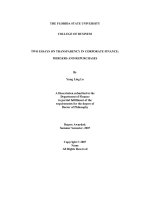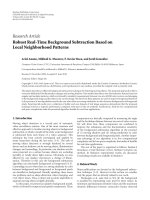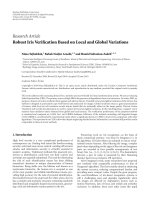Two topics on local theta correspondence
Bạn đang xem bản rút gọn của tài liệu. Xem và tải ngay bản đầy đủ của tài liệu tại đây (675.72 KB, 145 trang )
TWO TOPICS ON
LOCAL THETA CORRESPONDENCE
MA JIA JUN
(B.Sc., Soochow University)
A THESIS SUBMITTED
FOR THE DEGREE OF DOCTOR OF PHILOSOPHY
DEPARTMENT OF MATHEMATICS
NATIONAL UNIVERSITY OF SINGAPORE
2012
Declaration
I hereby declare that this thesis is my original work and it has been
written by me in its entirety.
I have duly acknowledged all the sources of information which have been
used in the thesis.
This thesis has also not been submitted for any degree in any university
previously.
Ma Jia Jun
20 February 2013
ACKNOWLEDGEMENTS
I would like to take this opportunity to acknowledge and thank those who
made this work possible.
I would like to express my deep gratitude to Prof. Chengbo Zhu, my
supervisor for his supervision and constant support. Prof. Zhu leads me
to this exciting research area, proposes interesting questions and always
provides illuminating suggestions to me during my study.
I am sincerely grateful to Prof. Hung Yean Loke, who have spent enor-
mous of time in patient discussion with me and given me lots of inspiring
advices. In the collaboration with Prof. Loke, I learnt many mathematics
from him. I am profoundly indebted to Prof. Soo Teck Lee, who launched
instructive seminars which deeply influenced this work. I express my sincere
thanks to Prof. CheeWhye Chin and Prof. De-Qi Zhang, who patiently
explained lots of concepts in algebraic geometry to me. I also would like
to thank Prof. Michel Brion, Prof. Wee Teck Gan, Prof. Roger Howe,
Prof. Jingsong Huang, Prof. Kyo Nishiyama, Prof. Gordan Savin and
Prof. Binyong Sun, for their stimulating conversations and suggestions.
I would like to offer my special thanks to my friends Ji Feng, Tang U-
Liang, Wang Yi, Ye Shengkui, Zhang Wengbin and Qu
´
ˆoc Anh Ngˆo. I have
learned a lot through seminars and conversations with them. I am sincerely
grateful to Wang Yi, who have read the manuscript and made helpful com-
ments. My acknowledgement also goes to all my classmates and the staffs
of Departement of mathematics, NUS, who have gave tremendous helps
during my PhD study. I also thank to users and creators of mathoverflow
and mathstackexcahnge for their accurate answers even to some simple
3
questions I posted. I would like to thanks my thesis examiners who give
lots of helpful suggestions in their reports.
I would like to express my sincerest appreciation to my family, especially
to my parents, for their support and encouragement throughout my study.
Last but not the least, it would be impossible to say enough about my
beloved wife Yongting Zhu. Without her supports, encouragement and
understanding, it would be impossible for me to finish this work.
Contents
1 Introduction 1
2 Preliminaries 3
2.1 Notation . . . . . . . . . . . . . . . . . . . . . . . . . . . . . 3
2.2 (g, K)-module . . . . . . . . . . . . . . . . . . . . . . . . . . 4
2.3 Local Theta correspondence . . . . . . . . . . . . . . . . . . 5
2.3.1 Reductive dual pairs . . . . . . . . . . . . . . . . . . 5
2.3.2 Definition of theta correspondence . . . . . . . . . . . 7
2.3.3 A lemma from Moeglin Vigneras and Waldspurger . . 9
2.3.4 Models of oscillator representation and U(g)
H
-action 11
2.3.5 Compact dual pairs . . . . . . . . . . . . . . . . . . . 16
2.3.6 Theta lifts of characters . . . . . . . . . . . . . . . . 20
2.3.7 Moment maps . . . . . . . . . . . . . . . . . . . . . . 23
2.4 Basic facts about derived functors . . . . . . . . . . . . . . . 30
2.4.1 Zuckerman functor . . . . . . . . . . . . . . . . . . . 31
2.4.2 A decomposition of derived functor module . . . . . . 32
2.4.3 A
q
(λ) and Vogan-Zuckerman’s Theorem . . . . . . . 34
2.5 Invariants of representations . . . . . . . . . . . . . . . . . . 39
2.6 Representations of algebraic groups . . . . . . . . . . . . . . 44
2.6.1 Quotients . . . . . . . . . . . . . . . . . . . . . . . . 44
2.6.2 Homogenous spaces . . . . . . . . . . . . . . . . . . . 45
2.6.3 Induced modules and their associated sheaves . . . . 46
i
ii CONTENTS
3 Derived functor modules of local theta lifts 49
3.1 Introduction . . . . . . . . . . . . . . . . . . . . . . . . . . . 49
3.2 A space with U(g)
H
action . . . . . . . . . . . . . . . . . . . 52
3.3 Line bundles on symmetric spaces and Theta lifts of characters 55
3.4 Transfer of K-types and the proof of Theorem A . . . . . . . 57
3.5 Examples . . . . . . . . . . . . . . . . . . . . . . . . . . . . 59
3.5.1 Transfer of unitary lowest weight modules lifted from
unitary characters . . . . . . . . . . . . . . . . . . . . 60
3.5.2 Transfer of theta lifts of unitary characters and uni-
tary lowest weight module of Hermitian symmetric
groups . . . . . . . . . . . . . . . . . . . . . . . . . . 69
3.A A surjectivity result of Helgason . . . . . . . . . . . . . . . . 78
4 Lifting of invariants under local theta correspondence 83
4.1 Introduction . . . . . . . . . . . . . . . . . . . . . . . . . . . 83
4.2 Natural filtrations on theta lifts . . . . . . . . . . . . . . . . 88
4.3 Some technical lemmas . . . . . . . . . . . . . . . . . . . . . 92
4.4 Isotropy representations of unitary lowest weight modules . . 95
4.4.1 Statement of the theorem . . . . . . . . . . . . . . . 95
4.4.2 Case by Case Computations . . . . . . . . . . . . . . 98
4.5 Isotropy representations of theta lifts of unitary characters . 104
4.6 Isotropy representations of theta lifts of unitary lowest weight
module . . . . . . . . . . . . . . . . . . . . . . . . . . . . . . 109
4.6.1 Statment of the main theorem . . . . . . . . . . . . . 109
4.6.2 proof of Theorem 84: general part . . . . . . . . . . . 111
4.6.3 Proof of Theorem 84: case by case computation . . . 116
Bibliography 127
Index 131
SUMMARY
This thesis contains two topics on local theta correspondence.
The first topic is on the relationship between derived functor modules
and local theta correspondences. Derived functor construction can trans-
fer representations between different real forms of a complex Lie group.
On the other hand, representations of different real forms also could be
constructed by theta correspondences of different real reductive dual pairs
(with same complexification). We first observe an equation on the image of
Hecke-algebras for see-saw pair, ω(U(g)
H
) = ω(U(h
′
)
G
′
), which generalize
the correspondence of infinitesimal characters. Then, we use it to study
the U(g)
K
-actions on the isotypic components of theta lifts and show that
the derived (Zuckerman) functor modules of theta lifts of one dimensional
representations (characters) are determined by their K-spectrums. We
identify families of derived functor modules constructed in Enright(1985),
Frajria(1991), Wallach(1994) and Wallach-Zhu (2004) with theta lifts of
unitary characters. One can rephrase the results in following form: the
derived functor modules of theta lifts of unitary characters are again (pos-
sibly direct sum of ) theta lifts of (other) characters (of possibly another
real form). By a restriction method, we also extend the theorem to theta
lifts of unitary highest weight modules as in a joint work with Loke and
Tang. All these results suggest that theta liftings and derived functors are
compatible operations.
In the second topic, we study invariants of theta lifts. Fixing a good K-
invariant filtration on a finite length (g, K)-module, the associated sheaf of
corresponding graded module is a K
C
-equivariant coherent sheaf supported
iv CONTENTS
on a union of nilpotent K
C
-orbit(s) in p
∗
. The fiber of the associated sheaf
at a point in general position is a rational representation of its stabilizer in
K
C
, called the isotropic representation at this point. The (genuine) virtual
character of the isotropic representation is an invariant. We calculated the
isotropic representations for theta lifts of unitary characters and unitary
highest weight modules under certain natural filtrations. As corollaries, we
recovered associated varieties and associated cycles of these representations.
Our result show that, outside the stable range, sometimes theta lifting
and taking associated cycle are compatible, while sometimes they are not
compatible.
Furthermore, we show that some families of unitary representations,
obtained by two step theta liftings, are “height-3” representations satisfying
a prediction of Vogan: the K-spectrums are isomorphic to the spaces of
global sections of certain K
C
-equivariant algebraic vector bundles defined
by their isotropic representations.
Since our calculations also suggest that there could be a notion of “lift-
ing” of isotropic representations compatible with theta lifting of representa-
tions. We propose a precise conjecture in the general cases, of an inductive
nature. A positive answer to these questions may contribute to a better
understanding of unipotent representations constructed by iterated theta
liftings.
List of Tables
2.1 Irreducible reductive dual pairs over C . . . . . . . . . . . . 6
2.2 Irreducible reductive dual pairs over R . . . . . . . . . . . . 6
2.3 Compact dual pairs . . . . . . . . . . . . . . . . . . . . . . . 16
2.4 Moment maps for compact dual pairs . . . . . . . . . . . . . 24
2.5 Moment maps for non-compact dual pairs . . . . . . . . . . 26
2.6 Z/4Z graded vector space for Type I dual pairs. . . . . . . . 28
2.7 Stable range for Type I dual pairs . . . . . . . . . . . . . . . 28
3.1 Transfer of unitary lowest weight modules . . . . . . . . . . 60
3.2 List of dual pairs I . . . . . . . . . . . . . . . . . . . . . . . 69
4.1 Compact dual pairs for unitary lowest weight modules . . . . 95
4.2 List of dual pairs II . . . . . . . . . . . . . . . . . . . . . . . 109
v
vi LIST OF TABLES
List of Figures
2.1 Diamond dual pairs . . . . . . . . . . . . . . . . . . . . . . . 25
3.1 A diamond of Lie algebras . . . . . . . . . . . . . . . . . . . 50
vii
viii LIST OF FIGURES
Chapter 1
Introduction
In this thesis, we focus on the “singular” part of the set of irreducible
representations of real classical groups. We study two topics both aim to
understand the role of irreducible (unitary) representations constructed by
local theta correspondence in the general theories of the representations of
real reductive groups.
The first topic is on the relationship between certain derived functor
constructions and local theta lifts. We studied the transfer of represen-
tations between different real forms of a complex classical Lie group via
derived functors of Zuckerman functors. The main result is that the de-
rived functor module of the theta lift (or, more generally, the irreducible
component of the maximal Howe quotient) of a character is characterized
by its K-spectrum (and its infinitesimal character).
The second topic is about the invariants of theta lifts. This part is build
on a joint work with Loke and Tang [LMT11a]. We computed the isotropic
representations of the theta lifts of unitary characters and unitary lowest
weight modules under a natural good filtration. Then we recovered the
Associated cycles of these representations. Furthermore, we showed that
stable range double theta lifts of unitary characters are height-3 represen-
tations satisfying a prediction of Vogan: their K-spectrums are isomorphic
to the spaces of global sections of certain K
C
-equivariant vector bundles
defined by their isotropic representations.
In Chapter 2, we introduce notations and some necessary facts for later
exploration. Most material in Chapter 2 may be known to experts. So
the reader may safely skip this chapter at first and read it when we refer
it in other chapters. In Chapter 3 and Chapter 4, we discuss above two
topics respectively. For the statement and discussions of main results of
each topics, see Introductions of these chapters.
1
2 CHAPTER 1. INTRODUCTION
Chapter 2
Preliminaries
2.1 Notation
We will introduce notation for the whole thesis, basically following Harish-
Chandra’s convention.
We use capital letters, for example G, denote real Lie groups. g
0
=
Lie(G) denote the (real) Lie algebra of G and g := (g
0
)
C
:= g
0
⊗
R
C be
the complexification of g
0
. K
G
(or simply K) denote certain maximal com-
pact subgroup of G. For real Lie group we always assume G is reductive.
We follow Wallach’s definition [Wal88, Section 2.1] of real reductive group.
Let g
0
= k
0
⊕ p
0
be the Cartan decomposition of g
0
respect to K
G
and
g = k ⊕ p be the complexification of this decomposition. The universal
algebra (over C) of g is denote by U(g). The adjoint representations of G
(resp. its derivative) on g
0
, g and U(g) are denoted by Ad (resp. ad). For
real reductive Lie group G,
G denote the isomorphism class of irreducible
admissible representations. For an isomorphism class σ of representation,
V
σ
denote a vector space realize σ; σ
∗
and V
∗
σ
denote their dual (contragre-
dient). Sometimes we may simply write σ for V
σ
, without explicitly fixing
a realization of σ.
For a vector space V , the symmetric algebra of V is denote by S(V ).
If V is finite dimensional, C[V ]
∼
=
S(V
∗
) denote the polynomial ring (ring
of regular functions) on V . There has natural grading on S(V ). S
d
(V )
denote the space of all elements with degree d and S
d
(V ) denote the space
of all elements with degree ≤ d.
Here variety means abstract variety, i.e. integral separated scheme of
finite type over algebraically closed field k
1
(c.f. [Har77, Section II.4]).
Since we will only study variety, we not distinguish algebraic subsets of
1
We only use C actually.
3
4 CHAPTER 2. PRELIMINARIES
variety and the corresponding reduced subschemes. The structure sheaf of
a scheme X is denoted by O
X
, the stalk at x ∈ X of a sheaf L is denoted
by L
x
. In particular, the local ring at x is denoted by O
X,x
(or simply O
x
).
For an open set U ⊂ X, L (U) denote the space of sections on U. For any
morphism f : Y → X, f
∗
and f
∗
denote the direct image and inverse image
functors. For a locally closed set Z ⊂ X, i
Z
: Z → X denote the inclusion
and k[Z] = i
∗
Z
O
X
(Z) denote the ring of regular functions on Z.
For a variety X with G-action, we say G act linearly (or geometrically)
on k[X] if it act by the translation action induced from the G-action on X.
We will use boldface letter to denote an array of numbers. We will
ignore zeros in the tail of an array of integers and write (a
1
, ··· , a
k
, 0, ···0)
by (a
1
, ··· , a
k
). Two array of numbers can be add or subtract coordinate-
wise. (a, b) denote the array obtained by appending b to a. a
r
denote the
array of integers by reverse the order of a. An array of “1”(resp. “0”) with
length p is denoted by 1
p
(resp. 0
p
). We assign lexicographical order on the
set of arrays and a ≥ 0 means all entries of a are non-negative.
I
n,m
denote the matrix of size n ×m with 1 on the diagonal. I
m
:= I
m,m
denote the identity matrix of size m ×m.
2.2 (g, K)-module
Let g be a complex Lie algebra and K be a compact Lie group such that
k = Lie(K)
C
is a complex Lie subalgebra of g. The pair (g, K) is a special
case of Harish-Chandra pairs.
Definition 1. A (g, K)-module is a pair (π, V ) with V a complex vector
space, π : g∪K → End
C
(V ) a representation of g and K satisfying following
conditions:
(1) dim span { π(K)v } < ∞ for any v ∈ V ;
(2) π(k)π(X) = π(Ad
k
X)π(k) for all k ∈ K, X ∈ g;
(3) The action of K on V is continuos. The differential of K-action is the
restriction of g-representation on k, i.e.
π(X)v = lim
t→0
1
t
(π(exp(tX))v −v) ∀v ∈ V, X ∈ k
0
.
Let C (g, K) be the category of (g, K)-module.
2.3. LOCAL THETA CORRESPONDENCE 5
For any σ ∈
K, let V (σ) be the σ-isotypic component of V . A (g, K)-
module is an admissible representation if V (σ) is finite dimension for all
σ ∈
K.
For a continuous (under certain topology) representation (π, V) of G ,
let
V
K
:= { v ∈ V | dim span {π(K)v } < ∞ }
be the space of K-finite vectors of V, which is a (g, K)-module called the
Harish-Chandra module of V. By Harish-Chandra’s theory, the Harish-
Chandra module of irreducible unitary representation is an irreducible ad-
missible (g, K)-module. Two irreducible unitary representations are iso-
morphic if and only if there Harish-Chandra modules are isomorphic. More-
over, every irreducible admissible (g, K)-module is the Harish-Chandra
module of an irreducible Hilbert space representation. Since (g, K)-module
play an importent role in the representation theory of real reductive groups,
we will focus on (g, K)-modules.
Later we will use following theorems from Harish-Chandra, Lepowsky
and McCollum [LM73].
Theorem 2 (c.f. [Wal88, Section 3.5.4 and Section 3.9]). Let G be a real
reductive group, K be its maximal compact subgroup.
1. Let W be an admissible (g, K)-module, γ ∈
K. X be an U(g)
K
and
K-invariant subspace of the γ isotypic component W (γ). Then (U(g)X)(γ) =
X ⊂ W (γ).
2. Let V and W be two irreducible (g, K)-modules. Let γ ∈
K such that
V (γ) and W (γ) both nonzero. Then V and W are equivalent as (g, K)-
module if and only if V (γ) and W (γ) are equivalent as U(g)
K
-module.
2.3 Local Theta correspondence
In this section, we review Howe’s definition [How89b] of (local) theta cor-
respondence (over R). We follow Howe’s notation.
2.3.1 Reductive dual pairs
Let k be a local field, W be an symplectic space over k, Sp(W ) be the
symplectic group of W which is the subgroup of GL(W ) preserves a non-
degenerate symplectic form on W. A pair of subgroup (G, G
′
) in Sp(W ) is
called reductive dual pair [How79b] over k, if
(i) G is centralizer of G
′
in Sp(W ) and vice versa;
6 CHAPTER 2. PRELIMINARIES
(ii) G and G
′
act on W absolute reductively, i.e. under any field ex-
tension, W decompose into direct sum of irreducible G-modules (or
G
′
-modules).
Every reductive dual pair (G, G
′
) can be decompose into direct sum of
irreducible reductive dual pairs: it is a decomposition of symplectic space
W =
s
i=1
W
i
such G = G
1
×···×G
s
, G = G
′
1
×···×G
′
s
and (G
i
, G
′
i
) are
irreducible reductive dual pairs in Sp(W
i
). We listed irreducible reductive
dual pairs over C (resp. R) in Table 2.1 (resp. Table 2.2, where H is the
set of quaternions).
G G
′
Sp(W )
Typ e I Sp(2n, C) O(m, C) Sp(2nm, C)
Type II GL(n, C) GL(m, C) Sp(2nm, C)
Table 2.1: Irreducible reductive dual pairs over C
G G
′
Sp(W )
Sp(2n, R) O(p, q, R) Sp(2n(p + q), R)
Type I Sp(2n, C) O(m, C) Sp(4nm, R)
U(r, s) U(p, q) Sp(2(p + q)(r + s), R)
O
∗
(2n) Sp(p, q) Sp(4n(p + q), R)
GL(n, R) GL(m, R) Sp(2nm, R)
Typ e II GL(n, C) GL(m, C) Sp(4nm, R)
GL(n, H) GL(m, H) Sp(8nm, R)
Table 2.2: Irreducible reductive dual pairs over R
From the classification of irreducible reductive dual pairs, or else, we
have following observations. For any real symplectic space W , define W
C
=
W ⊗
R
C and extend the real symplectic form C-linearly to W
C
. For real
reductive dual pair (G, G
′
) in Sp(W ), let G
C
and G
′
C
the complexification
of G and G
′
. Then (G
C
, G
′
C
) form a complex dual pair in Sp(W
C
). One
the other hand, we call a real symplectic subspace W of W
C
a real from
of W
C
if dim
R
W = dim
C
W
C
and the symplectic form restricted on W
is non-degenerate. Suppose (G
C
, G
′
C
) is a complex dual pair in complex
symplectic group Sp(W
C
), let G = G
C
∩Sp(W) and G
′
= G
′
C
∩Sp(W). By
a proper choice of real form W , (G, G
′
) will be a real reductive dual pair
in Sp(W ). We call (G, G
′
) a real form of (G
C
, G
′
C
) since G, G
′
, Sp(W) are
real froms of complex Lie group G
C
, G
′
C
, Sp(W
C
) respectively.
2.3. LOCAL THETA CORRESPONDENCE 7
2.3.2 Definition of theta correspondence
Write Sp for the big symplectic group Sp(W ) containing G and G
′
.
Sp
denote the metaplectic cover of Sp. Fix a unitary character of R, let ω be
the oscillator representation of
Sp and Y
∞
be the space of smooth vectors.
Denote R(
E) the infinitesimal equivalente classes of continuous irreducible
admissible representation of
E on locally convex topological vector spaces.
Let R(
E; Y
∞
) be the subset of R(
E) which can be realized as a quotient
of Y
∞
by an
E-invariant closed subspace.
For a reductive dual pair (G, G
′
) in Sp, choose a maximal compact
subgroup U of Sp such that K = U ∩ G and K
′
= U ∩ G
′
are maximal
compact subgroups of G and G
′
respectively. Let Y be the space of
U-
finite vectors in Y
∞
. For any subgroup E of G such that K
E
:= E ∩ U
is a maximal compact subgroup of E, let R(e,
K
E
; Y ) be the infinitesimal
equivalent classes of irreducible (e,
K
E
)-modules which can be realized as
a quotient of Y . All elements in R(
E; Y
∞
) and R(e,
K
E
; Y ) are genuine
representations of the double covering in the sense that the centers of
E
and
K act non-trivially.
Clearly taking Harish-Chandra module gives a inclusion R(
E; Y
∞
) →
R(e,
K
E
; Y ). For ρ ∈ R(
G; Y
∞
) (view as smooth representation of
G
in the sense of Casselman-Wallach), let ρ
0
be the corresponding (g,
K)-
module. Define
Ω
∞
Y
∞
,ρ
= Y
∞
T ∈Hom
G
(Y
∞
,ρ)
Ker (T)
and
Ω
Y ,ρ
0
= Y
T ∈Hom
g,
K
(Y ,ρ
0
)
Ker (T) .
By Lemma 5 in Section 2.3.3, as (g,
K) × (g
′
,
K
′
)-module,
Ω
Y ,ρ
0
∼
=
ρ
0
⊗ Θ(ρ
0
).
Howe [How89b] proved that Θ(ρ
0
) is a finite length (g
′
,
K
′
)-module with
infinitesimal character and it has a unique irreducible quotient θ(ρ
0
). Note
that the restriction to Y induces an injection
Hom
G
(Y
∞
, ρ) → Hom
g,
K
(Y , ρ
0
).
Therefore, the space of
K ×
K
′
-finite vectors in Ω
∞
Y
∞
,ρ
is a quotient of Ω
Y ,ρ
0
8 CHAPTER 2. PRELIMINARIES
and
Ω
∞
Y
∞
,ρ
= ρ
ˆ
⊗Θ
∞
(ρ)
where Θ
∞
(ρ) is a finite length smooth
G
′
-module and
ˆ
⊗ denote projective
tensor product
2
. Clearly, the Harish-Chandra module of Θ
∞
(ρ) is a non-
zero quotient of Θ(ρ
0
) and Θ
∞
(ρ) has a unique irreducible quotient θ
∞
(ρ)
with Harish-Chandra module θ(ρ
0
). However, the relationship between
Ω
∞
Y
∞
,ρ
and Ω
Y ,ρ
0
are subtle. It is not known in general at least to the
author.
Definition 3. We define the theta lifting map
θ : R(g,
K; Y ) → R(g
′
,
K
′
; Y )
by ρ
0
→ θ(ρ
0
). We also have the smooth version of theta lifting map:
θ
∞
: R(
G; Y
∞
) → R(
G
′
; Y
∞
)
defined by ρ → θ
∞
(ρ).
For any ρ
0
∈ R(g,
K; Y ), Θ(ρ
0
) is usually called the maximal Howe
quotient. ρ
0
→ Θ(ρ
0
) defines a map
Θ: R(g,
K; Y ) → C (g
′
,
K
′
)
whose image is in the subcategory of finite length (g
′
,
K
′
)-modules. We call
Θ the full theta lifting map. Similarly, ρ → Θ
∞
(ρ) defines map
Θ
∞
: R(
G; Y
∞
) → C (
G
′
).
Here C (
G
′
) denote the category of Casselman-Wallach
G
′
-representation
and the image of Θ
∞
is in the subcategory of finite length Casselman-
Wallach
G
′
-representations
Since the role of G and G
′
are symmetric, we will abuse notation by
using same symbols for maps from
G
′
-modules to
G-modules. In this thesis,
we will focus on the algebraic version of theta lifting, i.e. θ and Θ.
2
Actually, both ρ and Θ(ρ) will be nuclear spaces, there is only one reasonable
topological tensor product.
2.3. LOCAL THETA CORRESPONDENCE 9
2.3.3 A lemma from Moeglin Vigneras and Wald-
spurger
In this section, we prove a lemma essentially
34
from Moeglin, Vigneras and
Waldspurger [MVW87] for completeness. This lemma explains why Ω
Y ,ρ
0
is a tensor product.
At first, we review some basic properties of (g, K)-modules. For any
(g, K)-module V , V =
τ∈
K
V (τ) where V (τ) is the τ-isotypic component.
In particular, a vector v ∈ V has finite K-support, i.e., v is a finite sum
of vectors v
τ
∈ V (τ). There is a natural projection p
τ
of V to V (τ),
which could be realized by integration against the complex conjugation of
characters χ
τ
of τ over K. Now for any v ∈ V , integrate against
χ
v
=
v
τ
̸=0
χ
τ
(2.1)
on K is a projection onto U
v
∼
=
v
τ
̸=0
U(τ) fixing v. We call it p
v
.
For (g, K)-module U, define
ˇ
U to be the subspace Hom
C
(U, C)
K−finite
of
all K-finite vectors in Hom
C
(U, C). If U is admissible, then Hom
C
(U, V )
K−finite
∼
=
ˇ
U ⊗ V for any vector space V and (
ˇ
U)
ˇ
∼
=
U. If U is an irreducible (g, K)-
module, Hom
g,K
(U, U)
∼
=
C.
To prove the main result, we need following lemma.
Lemma 4. Let U be an irreducible admissible (g, K)-module. Let V be a
(g, K)-submodule in U ⊗ W where W is some vector space. Then there is
a subspace U
′
of W such that V = U ⊗ U
′
.
Proof. Let U
′
= { w ∈ W | U ⊗ Cw ⊂ V }. It is a subspace of W and
U ⊗ U
′
⊂ V . By quotient out of U ⊗ U
′
and viewing V/(U ⊗ U
′
) as a
submodule of U ⊗ W/U
′
, we only have to prove that V = 0 if U
′
= 0.
Suppose that V ̸= 0. Since V =
τ∈
K
V (τ), there is a τ ∈
K such
that the τ isotypic component V (τ) ̸= 0. In particular, there is some
0 ̸= v ∈ V (τ ) such that v =
s
i=1
u
i
⊗ u
′
i
with { u
i
} linearly independent
and u
′
1
̸= 0. Note that U(g)
K
and K act on the U(τ ) isotypic component
irreducibly since U is irreducible admissible. The subalgebra generated by
U(g)
K
and K actions in End
C
(U(τ)) is the whole algebra (by Jacobson
Density Theorem). In particular, there is a finite combination π of U(g)
K
3
They proved the lemma in p-adic case. They only need a projection to the space of
K-fixed vector. In our case, we have to project to K-isotypic component first.
4
I learned the argument from Gordan Savin.
10 CHAPTER 2. PRELIMINARIES
and K such that
π · u
i
=
u
1
if i = 1,
0 if i ̸= 1.
Hence u
1
⊗u
′
1
= π ·v ∈ V . Since U is irreducible, u
1
generate U. Therefore
0 ̸= u
′
1
∈ U
′
, which is contradict to U
′
= 0.
Let V be a ( g, K)-module and U be an irreducible admissible (g, K)-
module. Define a (g, K)-module (c.f. Section 3.2),
Ω
V,U
= V/N
V,U
, where N
V,U
=
T ∈Hom
g,K
(V,U)
Ker (T).
Lemma 5. Then the maximal quotient Ω
V,U
∼
=
U⊗U
′
with U
′
∼
=
Hom
g,K
(U, Ω
V,U
).
Moreover, Hom
g,K
(V, V ) act on U
′
by composition.
Proof. Replacing V by V /N
V,U
, we can assume
N
V,U
=
T ∈Hom
g,K
(V,U)
Ker (T) = 0,
i.e. V = Ω
V,U
. Let
ˇ
U
∼
=
Hom(U, C)
K−finite
be the dual of U in the category
of (g, K)-modules. Let W = (
ˇ
U ⊗ V )
g,K
be the co-invariant of (g, K) in
ˇ
U ⊗ V , which is the maximal quotient Ω
ˇ
U⊗V,C
by definition. Let p:
ˇ
U ×
V ⊗C → (
ˇ
U ⊗V )
g,K
= W be the corresponding projection. Define ϕ: V →
Hom
C
(
ˇ
U, W) by v → (ˇu → p(ˇu ⊗v)).
For any v ∈ V , let χ
v
be the projection defined by (2.1). Now
ϕ(v)(ˇu) =p(ˇu ⊗v) = p
ˇu ⊗
K
χ
v
(k)k · v dk
=p
(
K
χ
v
(k
−1
)k · ˇu dk) ⊗ v
∈ W.
Since χ
τ
(k
−1
) is the character of the dual τ
∗
of τ, ϕ(v) is in the space
Hom
C
(
ˇ
U
v
, W) ⊂ Hom
C
(
ˇ
U, W)
5
. Here
ˇ
U
v
=
v
τ
̸=0
U(ˇτ ) is finite dimension.
So ϕ(v) is K-finite and ϕ factor through U ⊗ W
∼
=
Hom
C
(
ˇ
U, W)
K−finite
.
One the other hand, ϕ is injective. In fact, by assumption N
V,U
= 0, for
each 0 ̸= v ∈ V , there is T ∈ Hom
g,K
(V, U) such that T (v) ̸= 0. So there is
a ˇu ∈
ˇ
U such that ˇu(T (v)) ̸= 0. Notice that f :
ˇ
U ⊗V
id⊗T
−−−→
ˇ
U ⊗U
paring
−−−→ C
factor through W and let
¯
f : W → C satisfies
¯
f ◦p = paring ◦(id ⊗T). We
have ϕ(v) ̸= 0 since
¯
f(ϕ(v)(ˇu)) ̸= 0.
Now we can view V as a (g, K)-submodule of U ⊗W via ϕ. By Lemma 4,
5
The inclusion is given by pre-composite with the projection onto
ˇ
U
v
2.3. LOCAL THETA CORRESPONDENCE 11
V = U ⊗U
′
, where U
′
is for some subspace of W .
Now, W = (
ˇ
U ⊗V )
g,K
∼
=
(
ˇ
U ⊗U ⊗U
′
)
g,K
∼
=
U
′
∼
=
Hom
g,K
(U, U ⊗U
′
)
∼
=
Hom
g,K
(U, V ). So we conclude that V
∼
=
U ⊗ Hom
g,K
(U, V ). It is clear
that Hom
g,K
(V, V ) act on the second factor.
2.3.4 Models of oscillator representation and U(g)
H
-
action
We will give some remarks on (Fock) models of oscillator representation
following from Howe [How89a] and J. Adams’ notes [Ada07], which is due
to Steve Kudla. Due to these remarks, we will prove following Proposition.
Proposition 6. Let (G, G
′
) and (H, H
′
) be a see-saw pair in Sp(W ) such
that H ≤ G and G
′
≤ H
′
. Let ω be an oscillator representation of
Sp(W ),
then as subalgebras of End
C
(Y ),
ω(U(g)
H
) = ω(U(g)
H
) = ω(U(h
′
)
G
′
) = ω(U(h
′
)
G
′
). (2.2)
Moreover, there exist a map Ξ: U(g)
H
→ U(h
′
)
G
′
(independent of real
forms, may not unique and not be algebra homomorphism) such that ω(x) =
ω(Ξ(x)).
Remark:
1. The above proposition provides a tool to translate the Hecke-algebra,
U(g)
H
, actions from one side to the other side in see-saw pair. We will
use this proposition to study the derived functor modules of theta lifts in
Chapter 3.
2. If (H, H
′
) = (G, G
′
), Proposition 44 will implies the well know for-
mula Z(g) = Z(g
′
), which will lead the correspondence of infinitesimal
characters, see [Prz96].
3. In Lee, Nishiyama and Wachi’s paper [LNW08], they also observed
(3.6) and use it to study a generalization of Capelli identity.
Let W
C
be a complex symplectic space with non-degenerate symplectic
form ⟨ , ⟩. Fix a non-trivial character ψ of C where view C as an abelian
complex Lie algebra. More precisely, ψ(z) = λz for some λ ∈ C
×
.
Define
Ω(W
C
) := T (W
C
)/I
where
T (W
C
) =
j∈N
W
C
⊗ ··· ⊗W
C
j times
12 CHAPTER 2. PRELIMINARIES
is the tensor algebra of W
C
and I is the two side ideal in T (W
C
) generated
by
{ v ⊗ w − w ⊗v −ψ(⟨v, w⟩) }.
Ω(W
C
) has a natural filtration induced by the natural filtration on T ( W
C
).
Let Ω
j
(W
C
) be the space of elements of degree less and equal to j and
Ω
j
(W
C
) be image of T
j
(W
C
). The corresponding graded algebra of Ω(W
C
)
will isomorphic to C[W
C
]. Let e = W
C
⊕ L be the Heisenb erg Lie algebra
of W
C
, where L
∼
=
C1 is the center of h. Let [v, w] = vw − wv be the
commutator and {v, w} = vw + wv be the anti-commutator . Now [v, w] =
⟨v, w⟩1 for any v, w ∈ W
C
. The complex symplectic group Sp(W
C
) has a
natural action on T (W
C
) and therefore induce an action on Ω(W
C
). Let
sp = sp(W
C
) be the complex Lie algebra of Sp(W
C
).
Lemma 7 ([Ada07, Section 2]). (i) Ω(W
C
)
∼
=
U(e)/⟨1 −ψ(1)⟩;
(ii) Ω
1
(W
C
)
∼
=
e;
(iii) Ω
1
(W
C
)/Ω
0
(W
C
)
∼
=
W
C
;
(iv) Ω
2
(W
C
)/Ω
1
(W
C
)
∼
=
S
2
(W
C
)
∼
=
sp(W
C
) via the action of Ω
2
(W
C
) on
Ω
1
(W
C
)/Ω
0
(W
C
)
∼
=
W
C
;
More precisely, sp(W
C
) ∋ x = {a, b} ∈ S
2
(W
C
) act on c ∈ W
C
∼
=
Ω
1
(W
C
) by x(c) = [{a, b}, c]/λ;
(v) Ω
2
(W
C
)
∼
=
sp ⋉ h is a semi-direct product of Lie algebra.
Fix a complex polarization of W
C
, i.e. a decomposition W
C
= X ⊕ Y
such that X and Y are maximal isotropic subspaces in W
C
. Define
Y := Ω(W
C
)/Ω(W
C
)X. (2.3)
Since Y
∼
=
X
∗
,
Y
∼
=
S(Y )
∼
=
S[X
∗
]
∼
=
C[X].
Let Ω(W
C
) act on Y
∼
=
Ω(W
C
)/Ω(W
C
)X by left multiplication. One can
verify that, Y act on Y by multiplying linear polynomials, and X act on
Y by differentiation. So Ω(W
C
) act on Y as polynomial coefficients dif-
ferential operators. Moreover, Ω(W
C
) act irreducibly and faithfully on Y .
By this representation, Ω(W
C
) isomorphic to as subalgebra (Weyl algebra)
End
◦
⊂ End
C
(Y ) as in [How89a]. The inclusion sp = S
2
(W
C
) ⊂ Ω
2
(W
C
)
induces map
ω
C
: U(sp) → Ω(W
C
)
∼
=
End
◦
.

